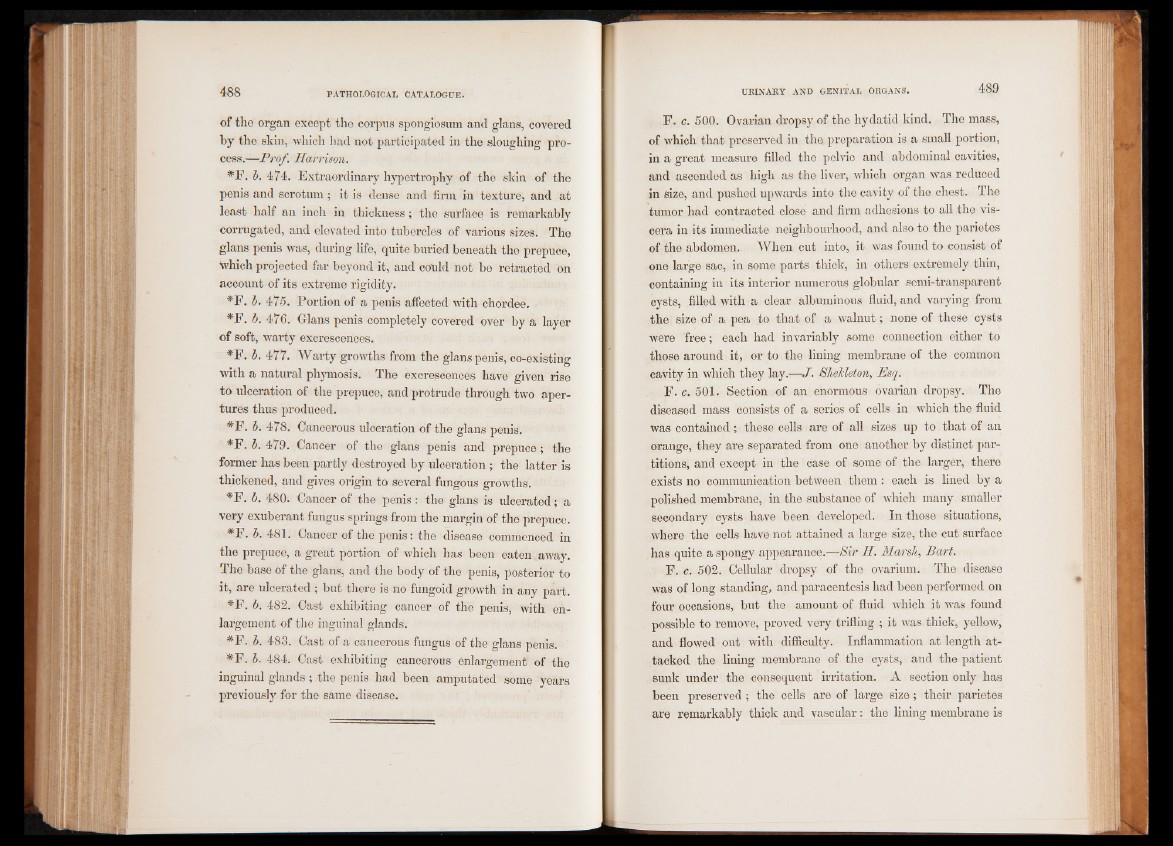
of the organ except the corpus spongiosum and glans, covered
by the skin, which had not participated in the sloughing process.—
Prof. Harrison.
#F. b. 474. Extraordinary hypertrophy of the skin of the
penis and scrotum; it is dense and firm in texture, and at
least half an inch in thickness; the surface is remarkably
corrugated, and elevated into tubercles of various sizes. The
glans penis was, during life, quite buried beneath the prepuce,
which projected far beyond it, and could not be retracted on
account of its extreme rigidity.
*F. b. 475. Portion of a penis affected with chordee.
*F. b. 476. Glans penis completely covered over by a layer
of soft, warty excrescences.
*F. b. 477. Warty growths from the glans penis, co-existing
with a natural phymosis. The excrescences have given rise
to ulceration of the prepuce, and protrude through two apertures
thus produced.
#F. b. 478. Cancerous ulceration of the glans penis.
*F. b. 479. Cancer of the glans penis and prepuce; the
former has been partly destroyed by ulceration ; the latter is
thickened, and gives origin to several fungous growths.
*F. b. 480. Cancer of the penis : the glans is ulcerated; a
very exuberant fungus springs from the margin of the prepuce.
#F. b. 481. Cancer of the penis: the disease commenced in
the prepuce, a great portion of which has been eaten away.
The base of the glans, and the body of the penis, posterior to
it, are ulcerated; but there is no fungoid growth in any part.
*F. b. 482. Cast exhibiting cancer of the penis, with enlargement
of the inguinal glands.
#F. b. 483. Cast of a cancerous fungus of the glans penis.
#F. b. 484. Cast exhibiting cancerous enlargement of the
inguinal glands; the penis had been amputated some years
previously for the same disease.
F. c. 500. Ovarian dropsy of the hydatid kind. The mass,
of which that preserved in the preparation is a small portion,
in a great measure filled the pelvic and abdominal cavities,
and ascended as high as the liver, which organ was reduced
in size, and pushed upwards into the cavity of the chest. The
tumor had contracted close and firm adhesions to all the viscera
in its immediate neighbourhood, and also to the parietes
of the abdomen. When cut into, it was found to consist of
one large sac, in some parts thick, in others extremely thin,
containing in its interior numerous globular semi-transparent
cysts, filled with a clear albuminous fluid, and varying from
the size of a pea to that of a walnut; none of these cysts
were free; each had invariably some connection either to
those around it, or to the lining membrane of the common
cavity in which they lay.—J. SheJcleton, Esq.
F. c. 501. Section of an enormous ovarian dropsy. The
diseased mass consists of a series of cells in which the fluid
was contained; these cells are of all sizes up to that of an
orange, they are separated from one another by distinct partitions,
and except in the case of some of the larger, there
exists no communication between them : each is lined by a
polished membrane, in the substance of which many smaller
secondary cysts have been developed. In those situations,
where the cells have not attained a large size, the cut surface
has quite a spongy appearance«—Sir H. Marsh, Bart.
F. c. 502. Cellular dropsy of the ovarium. The disease
was of long standing, and paracentesis had been performed on
four occasions, but the amount of fluid which it was found
possible to remove, proved very trifling ; it was thick, yellow,
and flowed out with difficulty. Inflammation at length attacked
the lining membrane of the cysts, and the patient
sunk under the consequent irritation. A section only has
been preserved; the cells are of large size; their parietes
are remarkably thick and vascular: the lining membrane is